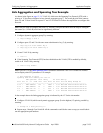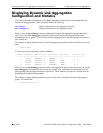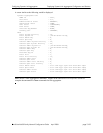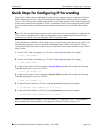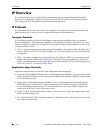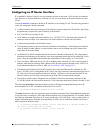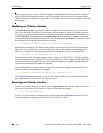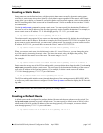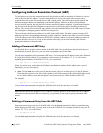
Configuring IP Quick Steps for Configuring IP Forwarding
OmniSwitch 6600 Family Network Configuration Guide April 2006 page 14-3
Quick Steps for Configuring IP Forwarding
Using only IP, which is always enabled on the switch, devices connected to ports on the same VLAN are
able to communicate at Layer 2. The initial configuration for all Alcatel switches consists of a default
VLAN 1. All switch ports are initially assigned to this VLAN. When another switch is added (stacked), all
of that switch’s ports are also assigned to VLAN 1. If additional VLANs are not configured on the switch,
the entire switch is treated as one large broadcast domain, and all ports receive all traffic from all other
ports.
Note. A VLAN’s operational status remains inactive until at least one active switch port is assigned to the
VLAN. Ports are considered active if they are connected to an active network device. Non-active port
assignments are allowed, but do not change the VLAN’s operational state.
To forward packets to a different VLAN on the switch, you must create a router interface on each VLAN.
The following steps show you how to enable IP forwarding between VLANs “from scratch”. If active
VLANs have already been created on the switch, you only need to create router interfaces on each VLAN
(Steps 5 and 6).
1 Create VLAN 1 with a description (e.g., VLAN 1) using the vlan command. For example:
-> vlan 1 name “VLAN 1”
2 Create VLAN 2 with a description (e.g., VLAN 2) using the vlan command. For example:
-> vlan 2 name “VLAN 2”
3 Assign an active port to VLAN 1 using the vlan port default command. For example, the following
command assigns port 1 on slot 1 to VLAN 1:
-> vlan 1 port default 1/1
4 Assign an active port to VLAN 2 using the vlan port default command. For example, the following
command assigns port 2 on slot 1 to VLAN 2:
-> vlan 2 port default 1/2
5 Create an IP router interface on VLAN 1 using the ip interface command. For example:
-> ip interface vlan-1 address 171.10.1.1 vlan 1
6 Create an IP router interface on VLAN 2 using the ip interface command. For example:
-> ip interface vlan-2 address 171.11.1.1 vlan 2
Note. For information about creating a VLAN see Chapter 4, “Configuring VLANs.” For information
about creating an IP router interface, see “Configuring an IP Router Interface” on page 14-7



